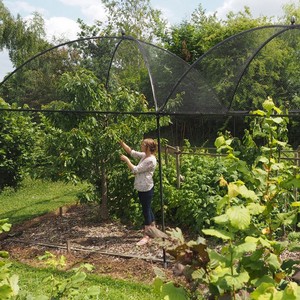.
Decades of my life passed before I knew anything was missing. True to form, lacking knowledge about gardening never stopped me from knowing what it was all about. The grand gift of Providence to all. We are set on this garden of Earth, soil, plants, sun/moon, livestock, pastures, weather, poof, we're each an expert. It's just dirt, right?
.
For the few choosing to seriously Garden, realization arrives, in our industrialized era, we have no vocabulary to describe gardening.
.
Little time to go deeper, instead, will give you a huge hint about what our era has lost. Providence never separated horticulture from agriculture. Still doesn't. We separate it at our own peril, and do. Mostly without realization. No judgment. How could I? Lived decades, seriously Gardening, before awakening.
.
All of the, above, is about the gate, below. Secondarily about its brick wall.

Pic, above, here.
.
So, the gate, above.
.
Pretty, is obvious. It's form chosen with love, care, purpose.
.
Go further, to its function, look past its form.
.
Can you tell me the gate's diligent purpose in function? Beyond the macro, to the micro.
.
Seriously, why is the gate formed to function exactly as it is? Beyond pretty, there is serious business taking place with this gate.
.
How did I discover the purpose of this gate's function? Working for a client, on a farm. As Providence intended, discovery working from a pastoral life. Not that industrialization is bad, but the lifestyle of stewardship pastoral living conveys into us has been lost, in the macro, and too much of the micro, with industrialization.
.
Getting to the understanding of this gate, and its function, was deeply humbling. What else am I not
seeing? If I didn't get-it about this type of gate for so many decades.
.
Wildly tempted to not tell you, here, the purpose of this gate's function. Wanting you to think for yourself. Not a bit of arrogance, more, sharing in how I adore to learn.
.
My grandmother would have known exactly why this gate has its form for its function. Born early 20th century, raised on a farm, pastoral. She was living fully in the industrialized era by the time I was born.
.
No. You figure it out. The gate's full purpose. My gift to you, figuring it out.
.
Garden & Be Well, XO T
.
Would not have figured it out myself, without having clients on farms. Once discovered, OBVIOUS, basic. Simplicity of answer, a life epiphany. Pastorally, the answer is 1st order thinking. Industrialized, I could not have answered it, without dipping into pastoral. What more have we lost, living industrialized?
.
Remember your math book from high school? It would have a few of the answers at the back of the book, so you could check your work, but not all. Ha, this is one of those. The answer is not down here, it's for you to own and enjoy.
.

Pic, above, a gate in my garden.
.
This gate, above, would be no good, for a potager walled garden. Chickens can get thru. Lose an entire crop of seedlings? Damage beyond repair dozens of crop plants? Not an option, when the food you grow is mostly the only food you have.























